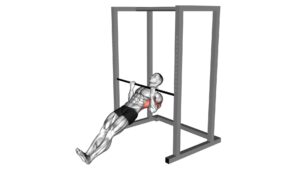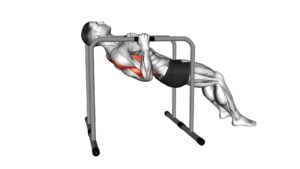Inverted Row – Video Exercise Guide & Tips

Are you looking for a challenging and effective exercise to strengthen your back and upper body? Look no further than the inverted row!
Watch This Exercise Video
This video exercise guide and tips will show you how to properly perform this exercise using just your bodyweight and a bar.
With variations and progressions included, you can customize your workout to suit your fitness level.
Get ready to take your strength training to new heights with the inverted row!
Key Takeaways
- The inverted row targets back muscles including latissimus dorsi, rhomboids, and trapezius.
- It improves posture and upper body strength.
- The exercise activates biceps, forearms, and core muscles.
- It can be modified for different fitness levels.
Benefits of the Inverted Row
To fully understand the benefits of the Inverted Row, you need to be aware of the muscles it targets and the overall impact it can have on your strength training routine. This exercise primarily works your back muscles, including the latissimus dorsi, rhomboids, and trapezius. By engaging these muscles, the Inverted Row helps to improve your posture and upper body strength. Additionally, this exercise activates your biceps, forearms, and core muscles, providing a full-body workout.
One of the key health benefits of the Inverted Row is improved muscle activation. As you pull your body weight towards the bar, your back muscles are forced to work harder to stabilize and control the movement. This leads to increased muscle activation and growth, helping you build a stronger and more defined back.
Another advantage of the Inverted Row is its impact on your overall strength training routine. By incorporating this exercise into your workouts, you can improve your pulling strength, which is essential for movements like pull-ups and rows. Additionally, the Inverted Row helps to balance out your upper body muscles, as it targets the muscles that often get neglected during pressing exercises. This can help prevent imbalances and reduce the risk of injuries.
Equipment Needed for the Inverted Row
Are you wondering what equipment you need for the Inverted Row? Well, you'll be glad to know that this exercise doesn't require any fancy or expensive equipment. In fact, all you need is a sturdy horizontal bar that can support your body weight. This can be a pull-up bar, a Smith machine, or even a sturdy table at home.
When performing the Inverted Row, it's important to have a strong grip. Grip strength plays a crucial role in this exercise as it helps you maintain control and stability throughout the movement. So, make sure to engage your hands and forearms during the exercise to improve your grip strength.
Now, let's talk about some common mistakes to avoid in the Inverted Row. One mistake is using too much momentum to complete the movement. Remember, the goal is to engage your muscles and control the movement, so avoid swinging your body or using excessive momentum. Another mistake isn't keeping your body in a straight line. To get the most out of the exercise, maintain proper form by keeping your body straight from head to toe.
Now that you know the equipment needed and the common mistakes to avoid, let's move on to the next section and learn about the proper form and technique for the Inverted Row.
Proper Form and Technique for the Inverted Row
Mastering proper form and technique is essential for maximizing the benefits of the Inverted Row exercise. To perform this exercise correctly, start by positioning yourself underneath a barbell or a suspension trainer. Grab the bar or handles with an overhand grip, slightly wider than shoulder-width apart. Keep your body in a straight line from your head to your heels.
One common mistake is allowing your hips to drop or sag during the movement. This not only reduces the effectiveness of the exercise but also puts unnecessary strain on your lower back. To avoid this, engage your core muscles and maintain a straight line throughout the entire movement.
Another mistake is pulling with your arms instead of using your back muscles. Remember, the Inverted Row primarily targets your upper back muscles, including the rhomboids, latissimus dorsi, and trapezius. Focus on squeezing your shoulder blades together as you pull yourself up, using your back muscles to initiate the movement.
Variations and Progressions of the Inverted Row
Try incorporating different variations and progressions of the Inverted Row to challenge your upper back muscles and continuously improve your strength and performance.
By modifying the traditional inverted row, you can target specific muscles, increase the difficulty level, and add variety to your workout routine.
One modification you can try is the single-arm inverted row. Instead of using both arms to pull yourself up, use only one arm while keeping the other arm extended. This variation increases the demand on your back muscles and also engages your core for stability.
To take your inverted row to the next level, you can try advanced variations such as the feet-elevated inverted row or the weighted inverted row. Elevating your feet on a bench or box challenges your upper back even more, as you have to work against gravity to pull yourself up. Adding weights, such as a weight plate or a dumbbell, increases the resistance and further intensifies the exercise.
Remember to maintain proper form and technique throughout these variations. Keep your body in a straight line, engage your core, and pull your shoulder blades together as you pull yourself up. Start with lighter weights or lower elevations and gradually progress as your strength improves.
Incorporating these inverted row modifications and advanced variations into your workout routine won't only enhance your upper back strength but also bring variety and excitement to your training sessions. Keep challenging yourself and watch your strength and performance soar to new heights.
Tips for Effective Inverted Row Training
To maximize your inverted row training, prioritize proper form and technique. By following these tips, you can enhance your performance and achieve better results:
- Maintain a straight body position: Avoid sagging or arching your back during the exercise. Keep your body in a straight line from head to toe.
- Engage your core: Activate your abdominal muscles throughout the movement to stabilize your body and prevent excessive swinging.
- Squeeze your shoulder blades: Focus on retracting your shoulder blades together at the top of the movement. This helps target the muscles of your upper back effectively.
- Avoid common mistakes: Don't use momentum to pull yourself up. Instead, rely on the strength of your upper body to perform the exercise correctly.
For optimal results, it's recommended to perform 3-4 sets of 8-12 repetitions of the inverted row. This rep range allows you to challenge your muscles while maintaining proper form. Adjust the difficulty level by adjusting your body angle or using additional weights as you progress.
Remember to listen to your body and gradually increase the intensity of your workout over time. With consistent training and attention to form, you'll develop a stronger and more defined back.
Frequently Asked Questions
What Are Some Common Mistakes to Avoid While Performing the Inverted Row?
When performing the inverted row, it's important to be mindful of some common mistakes to avoid.
First, make sure you have a proper grip and body alignment. This means gripping the bar tightly and keeping your body straight and in line.
Additionally, don't forget to engage your core muscles throughout the exercise.
By avoiding these mistakes, you'll be able to maximize the effectiveness of the inverted row and achieve better results.
Keep up the good work!
Can the Inverted Row Help Improve Posture?
The inverted row is a fantastic exercise for improving your posture. By targeting the muscles in your upper back and shoulders, it helps to strengthen and stabilize your spine, promoting better alignment.
Not only that, the inverted row also engages your core and arms, providing a full-body workout. Plus, there are various variations of the inverted row that you can try to add variety and challenge to your routine.
Is It Necessary to Warm up Before Starting the Inverted Row Exercise?
Before starting the inverted row exercise, it's essential to warm up your muscles. A proper warm-up increases blood flow, prepares your body for the workout, and reduces the risk of injury.
Additionally, warming up helps improve your performance during the exercise. It's also crucial to maintain proper form while doing the inverted row to maximize its benefits. By focusing on your form, you engage the targeted muscles effectively and prevent strain or imbalances.
Can the Inverted Row Be Modified for Individuals With Limited Upper Body Strength?
Yes, the inverted row can be modified for individuals with limited upper body strength. By using a resistance band or adjusting the angle of the body, you can make the exercise more manageable. These modifications allow you to still engage your back muscles and build strength while working within your current abilities.
The benefits of modified inverted rows include improved posture, increased upper body strength, and enhanced core stability. Don't let limited strength hold you back, modify and conquer!
How Often Should the Inverted Row Be Included in a Workout Routine to See Results?
To see optimal results from the inverted row, it's important to include it in your workout routine regularly. By incorporating this exercise into your routine, you can experience a variety of benefits.
The inverted row targets your back, arms, and core, helping to build strength and improve posture. Aim to perform this exercise at least 2-3 times per week, allowing for adequate rest and recovery between sessions.
Consistency and effort are key to achieving the desired outcomes from the inverted row. Keep pushing yourself and you'll see the results you're looking for.
Conclusion
Incorporating the inverted row into your workout routine can offer numerous benefits for your upper body strength and overall fitness.
With minimal equipment needed, this exercise can be easily performed at home or in the gym.
By maintaining proper form and technique, you can target your back, arms, and core muscles effectively.
As you progress, you can also explore different variations and progressions to continually challenge yourself.
Stay committed and enjoy the rewards of a stronger and more toned physique.
Keep pushing yourself, you've got this!

Author
Years ago, the spark of my life’s passion ignited in my mind the moment I stepped into the local gym for the first time. The inaugural bead of perspiration, the initial endeavor, the very first surge of endorphins, and a sense of pride that washed over me post-workout marked the beginning of my deep-seated interest in strength sports, fitness, and sports nutrition. This very curiosity blossomed rapidly into a profound fascination, propelling me to earn a Master’s degree in Physical Education from the Academy of Physical Education in Krakow, followed by a Sports Manager diploma from the Jagiellonian University. My journey of growth led me to gain more specialized qualifications, such as being a certified personal trainer with a focus on sports dietetics, a lifeguard, and an instructor for wellness and corrective gymnastics. Theoretical knowledge paired seamlessly with practical experience, reinforcing my belief that the transformation of individuals under my guidance was also a reflection of my personal growth. This belief holds true even today. Each day, I strive to push the boundaries and explore new realms. These realms gently elevate me to greater heights. The unique combination of passion for my field and the continuous quest for growth fuels my drive to break new ground.







